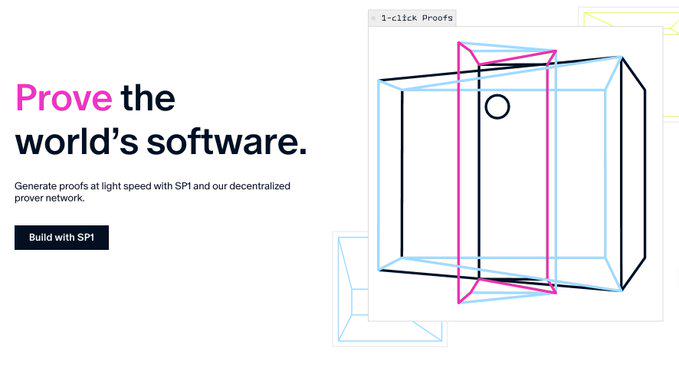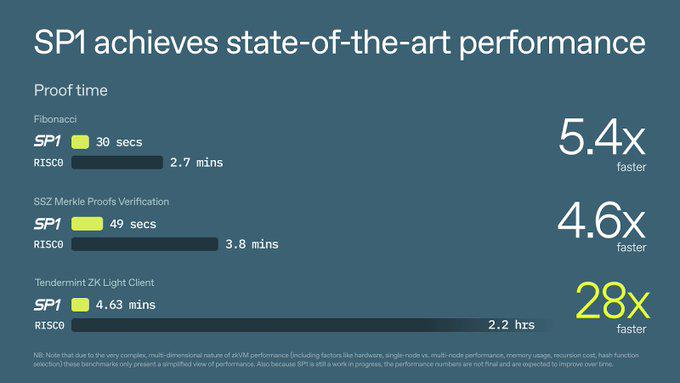Succinct, which has raised 5500 million RMB in funding, is a top ZK project with two rounds of investment led by paradigm.
The core product of this top ZK project is SP1, which is also the fastest zkVM currently.
• Leading performance, with proof speed up to 28 times faster than other zkVMs and at a fraction of the cost.
• Support writing ZKP in Rust, reuse existing code base, and increase development efficiency by 100 times.
• Supports production-level use cases, has undergone top-level audits, and has been adopted by major projects such as Polygon and Celestia.
1. What is SP1?
SP1 is a general-purpose zero-knowledge virtual machine (zkVM) that allows developers to write ordinary code in Rust (or any language that supports LLVM compilation) and generate efficient zero-knowledge proofs for verifying the correct execution of the program.

Simply put, SP1 allows developers to quickly build verifiable computing applications with cryptographic security using familiar programming languages without having to delve into complex cryptographic theory.
The core innovation of SP1 is that it significantly lowers the development threshold of zero-knowledge proof while maintaining top-level performance and flexibility. It makes ZKP as simple as writing ordinary software, and allows blockchain infrastructure (such as Rollup, cross-chain bridges, oracles, etc.) to achieve verifiability through maintainable code.
Zero-knowledge proof (ZKP) can prove the correctness of a certain calculation without leaking any input data. This capability has endless application scenarios in blockchain:
- Capacity expansion: Through Rollup, ZKP can compress a large number of transactions into one proof, significantly reducing the burden on the main chain.
- Interoperability: ZKP can verify the status of different chains and facilitate cross-chain communication.
- Privacy: ZKP ensures the privacy of transactions or states and protects user data.
- Bridges and Oracles: ZKP allows off-chain data or calculations to be verified trustlessly on the chain. However, the complexity of traditional ZKP development can be described as a "nightmare". It requires a professional cryptography team, several years of development cycle and high maintenance costs.
The emergence of SP1 has completely changed this situation.
2. Features of SP1
1. The fastest and most powerful zkVM
It is 4-28 times faster than other zkVMs on real blockchain workloads (such as light client verification, Rollup, etc.), and is even comparable to hand-optimized dedicated circuits. Its latest version, SP1 Turbo (v4.0.0), only takes 40 seconds to verify Ethereum mainnet blocks when running on a GPU cluster, with a cost as low as a few cents.

2. Support for writing ZKP in Rust
SP1 allows developers to write ZKP logic in Rust and directly reuse existing Rust ecosystem libraries (such as revm, reth, alloy, etc.).
Developers can simply modify the existing blockchain node code to generate ZKP, eliminating the trouble of writing complex circuits from scratch.
3. Precompilation: The secret weapon of performance
SP1 introduces a "precompile" mechanism that is highly optimized for common cryptographic operations such as keccak, sha256, signature verification, etc. These precompiles significantly reduce computational overhead, making SP1 even more powerful when handling complex blockchain workloads. For example, SP1 runs the ZK Tendermint light client, directly reducing the verification time from 2.2 hours to 4.6 minutes.
4.100% open source, code security
SP1 is 100% open source (MIT/Apache 2.0 license). Its modular architecture allows developers to customize "pre-compilation" to optimize performance for specific use cases. Unlike traditional closed-source zkVM, SP1 embraces community contributions and has attracted developers from teams such as Polygon, Celestia, and Sovereign Labs to work together to improve it.
SP1 has been audited multiple times by several top ZK security companies and achieved an excellent result of "zero high-risk vulnerabilities" in public audit competitions.
5. High-quality partners
Polygon, Celestia, Avail, Taiko, etc. have adopted Succinct's SP1 to build ZKP, safeguarding more than $1 billion in on-chain assets (TVL). From Rollup to cross-chain bridges, from oracles to privacy protocols, SP1 is becoming the standard for blockchain infrastructure.
3. Application scenarios of SP1
SP1 implements many use cases in blockchain:
- Rollup: Use SP1 to build ZK Rollup, generate zero-knowledge proofs of state transitions, connect to main chains such as Ethereum or Bitcoin, and achieve high throughput and low cost. For example, OP Succinct uses SP1 to provide a production-level proof engine for OP Stack.
- Cross-chain bridge: SP1 can verify the consensus of Layer 1 (such as Tendermint or Ethereum light client) and build a secure and efficient cross-chain bridge. For example, SP1 Blobstream verifies Celestia's data root on Ethereum, and SP1 Vector relays Avail's Merkle root to Ethereum.
- Interoperability: With SP1, Rollups can achieve rapid finality and interoperability, helping projects such as Polygon’s AggLayer.
- Oracle: SP1 supports large-scale off-chain computing (such as historical status query, on-chain machine learning) and generates verifiable proofs on the chain, significantly reducing Gas costs.
- Privacy: SP1 enables private transactions and states, keeping user data secure.
- Aggregation: SP1 can aggregate similar ZKPs to further reduce on-chain verification costs. Projects such as Nebra are exploring this direction.












